.
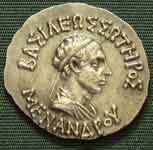
Coin of Menander. Greek legend, BASILEOS SOTHROS MENANDROY lit. "Saviour King Menander".
Obv: Diademed bust of king Polyxenios. Greek legend: BASILEOS EPIFANOIS SOTIROS POLYXENOY "Saviour King Polyxenios, Manifestation of God on Earth"
Rev: Athena with buckler and throwing a thunderbolt. Kharoshthi legend: MAHARAJASA PRACACHASA TRATARASA PALASINASA "Saviour King Polyxenios, Manifestation of God on Earth".
Menander I (known as Milinda in Sanskrit and Pali) was one of the rulers of the Indo-Greek Kingdom in northern India from 155 or 150 to 130 BC.
A renowned Indo-Greek king
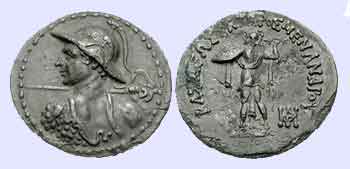
Tetradrachm of Menander I in Greco-Bactrian style (Alexandria-Kapisa mint) [Source].
Obv: King Menander throwing a spear.
Rev: Athena with thunderbolt. Greek legend: BASILEOS SOTIROS MENANDROY "King Menander, the Saviour".
His territories covered the eastern dominions of the divided Greek empire of Bactria (from the areas of the Panjshir and Kapisa) and extended to the modern Pakistani province of Punjab with diffuse tributaries to the south and east, probably as far as Mathura.
His capital is supposed to have been Sagala, a very prosperous city in northern Punjab (modern Sialkot).
He is one of the few Bactrian kings mentioned by Greek authors, among them Apollodorus of Artemit, quoted by Strabo, who claims that the Greeks from Bactria were even greater conquerors than Alexander the Great, and that Menander was one of the two Bactrian kings, with Demetrius, who extended their power farthest into India:
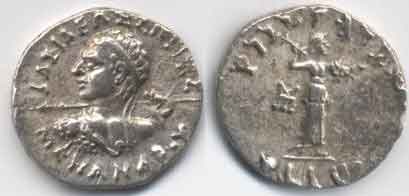
Silver drachm of Menander I (155-130 BC).
Obv: Greek legend, BASILEOS SOTEROS MENANDROY lit. "Saviour King Menander".
Rev: Kharosthi legend: MAHARAJA TRATASA MENADRASA "Saviour King Menander". Athena advancing right, with thunderbolt and shield. Taxila mint mark.
"The Greeks who caused Bactria to revolt grew so powerful on account of the fertility of the country that they became masters, not only of Ariana, but also of India, as Apollodorus of Artemita says: and more tribes were subdued by them than by Alexander-- by Menander in particular (at least if he actually crossed the Hypanis towards the east and advanced as far as the Imaüs), for some were subdued by him personally and others by Demetrius, the son of Euthydemus the king of the Bactrians; and they took possession, not only of Patalena, but also, on the rest of the coast, of what is called the kingdom of Saraostus and Sigerdis. In short, Apollodorus says that Bactriana is the ornament of Ariana as a whole; and, more than that, they extended their empire even as far as the Seres and the Phryni." (Strabo 11.11.1 [1])
Strabo also suggests that these Greek conquests went as far as the capital Pataliputra in northeastern India (today Patna):
"Those who came after Alexander went to the Ganges and Pataliputra" (Strabo, 15.698).
The Indian records also describe Greek attacks on Mathura, Panchala, Saketa, and Pataliputra. This is particularly the case of some mentions of the invasion by Patanjali around 150 BC, and of the Yuga Purana, which describes Indian historical events in the form of a prophecy:
"After having conquered Saketa, the country of the Panchala and the Mathuras, the Yavanas (Greeks), wicked and valiant, will reach Kusumadhvaja. The thick mud-fortifications at Pataliputra being reached, all the provinces will be in disorder, without doubt. Ultimately, a great battle will follow, with tree-like engines (siege engines)." (Gargi-Samhita, Yuga Purana chapter, No5).
In the West, Menander seems to have repelled the invasion of the dynasty of Greco-Bactrian usurper Eucratides, and pushed them back as far as the Paropamisadae, thereby consolidating the rule of the Indo-Greek kings in the northern part of the Indian Subcontinent.
The Milinda Panha gives some glimpses of his military methods:
"Has it ever happened to you, O king, that rival kings rose up against you as enemies and opponents?
-Yes, certainly.
-Then you set to work, I suppose, to have moats dug, and ramparts thrown up, and watch towers erected, and strongholds built, and stores of food collected?
-Not at all. All that had been prepared beforehand.
-Or you had yourself trained in the management of war elephants, and in horsemanship, and in the use of the war chariot, and in archery and fencing?
-Not at all. I had learnt all that before.
-But why?
-With the object of warding off future danger."
(Milinda Panha, Book III, Chap 7)
His reign was long and successful. Generous findings of coins testify to the prosperity and extension of his empire (with finds as far as Britain): the finds of his coins are the most numerous and the most widespread of all the Indo-Greek kings. Precise dates of his reign, as well as his origin, remain elusive however. Guesses among historians have been that Menander was either a nephew or a former general of the Greco-Bactrian king Demetrius I, but the two kings are now thought to be separated by at least thirty years. Menander's predecessor in Punjab seems to have been the king Apollodotus I.
Menander's empire survived him in a fragmented manner until the last Greek king Strato II disappeared around 10.
Menander was the first Indo-Greek ruler to introduce the representation of Athena Alkidemos ("Athena, saviour of the people") on his coins, probably in reference to a similar statue of Athena Alkidemos in Pella, capital of Macedon. This type was subsequently used by most of the later Indo-Greek kings.
Menander and Buddhism
The Milinda Pañha
Main article: Milinda Panha
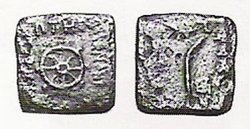
A coin of Menander I with a Buddhist eight-spoked wheel. [Source]
Obv: Greek legend, BASILEOS SOTEROS MENANDROY lit. "Saviour King Menander" with eight-spoked wheel.
Rev: Kharosthi legend MAHARAJA TRATASA MENADRASA "Saviour King Menander", with palm of victory.
According to tradition, Menander embraced the Buddhist faith, as described in the Milinda Pañha, a classical Pali Buddhist text on the discussions between Milinda and the Buddhist sage Nāgasena. He is described as constantly accompanied by a guard of 500 Greek ("Yonaka") soldiers, and two of his counsellors are named Demetrius and Antiochus.
In the Milindanpanha, Menander is introduced as
"King of the city of Sâgala in India, Milinda by name, learned, eloquent, wise, and able; and a faithful observer, and that at the right time, of all the various acts of devotion and ceremony enjoined by his own sacred hymns concerning things past, present, and to come. Many were the arts and sciences he knew--holy tradition and secular law; the Sânkhya, Yoga, Nyâya, and Vaisheshika systems of philosophy; arithmetic; music; medicine; the four Vedas, the Purânas, and the Itihâsas; astronomy, magic, causation, and magic spells; the art of war; poetry; conveyancing in a word, the whole nineteen. As a disputant he was hard to equal, harder still to overcome; the acknowledged superior of all the founders of the various schools of thought. And as in wisdom so in strength of body, swiftness, and valour there was found none equal to Milinda in all India. He was rich too, mighty in wealth and prosperity, and the number of his armed hosts knew no end." (The Questions of King Milinda, Translation by T. W. Rhys Davids, 1890).
Buddhist tradition relates that, following his discussions with Nāgasena, Menander adopted the Buddhist faith:
"May the venerable Nâgasena accept me as a supporter of the faith, as a true convert from to-day onwards as long as life shall last!" (The Questions of King Milinda, Translation by T. W. Rhys Davids, 1890).
He then handed over his kingdom to his son and retired from the world:
"And afterwards, taking delight in the wisdom of the Elder, he handed over his kingdom to his son, and abandoning the household life for the houseless state, grew great in insight, and himself attained to Arahatship!" (The Questions of King Milinda, Translation by T. W. Rhys Davids, 1890)
There is however little besides this testament to indicate that Menander in fact abdicated his throne in favor of his son. Based on numismatic evidence, Sir Tarn believes that he in fact died, leaving his wife Agathocleia to rule as a regent, until his son Strato could rule properly in his stead. Despite the success of his reign, it is clear that after his death, his "loosely hung" empire splintered into a variety of Indo-Greek successor kingdoms, of various size and stability.
Other Indian accounts
A 2nd century BC relief from a Buddhist stupa in Bharhut, in eastern Madhya Pradesh (today at the Indian Museum in Calcutta), represents a foreign soldier with the curly hair of a Greek and the royal headband with flowing ends of a Greek king, and may be a depiction of Menander. In his left hand, he hold a branch of ivy, symbol of Dionysos. Also parts of his dress, with rows of geometrical folds, are characteristically Hellenistic in style. On his sword appears the Buddhist symbol of the three jewels, or Triratana.
A Buddhist reliquary found in Bajaur bears a dedicatory inscription referring to "the 14th day of the month of Kārttika" of a certain year in the reign of "Mahārāja Minadra" ("Great King Menander"):
"Minadrasa maharajasa Katiassa divasa 4 4 4 11 pra[na]-[sa]me[da]... (prati)[thavi]ta pranasame[da]... Sakamunisa"
"On the 14th day of Kārttika, in the reign of Mahārāja Minadra, (in the year ...), (the corporeal relic) of Sakyamuni, which is endowed with life... has been established" [2]
According to an ancient Indian source, the Mahavamsa, Greek monks seem to have been active proselytizers of Buddhism during the time of Menander: the Yona (Greek) Mahadhammarakkhita (Sanskrit: Mahadharmaraksita) is said to have come from “Alasandra” (thought to be Alexandria-of-the-Caucasus, the city founded by Alexander the Great, near today’s Kabul) with 30,000 monks for the foundation ceremony of the Maha Thupa ("Great stupa") at Anuradhapura in Sri Lanka, during the 2nd century BC:
"From Alasanda the city of the Yonas came the thera ("elder") Yona Mahadhammarakkhita with thirty thousand bhikkhus." (Mahavamsa, XXIX [3])
These elements tend to indicate the importance of Buddhism within Greek communities in northwestern India, and the prominent role Greek Buddhist monks played in them, probably under the sponsorship of Menander.
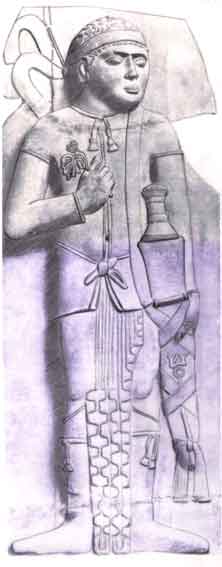
Probable Indo-Greek king, Bharhut, 2nd century BC.
Photo of the same relief: [1]
Boardman comments on this relief: "One striking figure of a warrior decorating one of the balustrade posts has often been discussed, and sometimes even described as a Greek. He is certainly meant to be a foreigner, perhaps more generically foreign than specific in nationality, and most of his dress probably belongs somewhere in Parthia, but... his head with the curly short hair and headband with flying ends is Greek. .. The warrior's dress is gathered in vertical folds between his legs... It has no local antecedents and looks most like Greek Late Archaic mannerism." (Boardman, The Diffusion of Classical Art in Antiquity)
Susan Huntington, in her book "The art of ancient India" positively identifies the subject as a Greek king in India.
The sword is decorated with the Buddhist symbol of the triratana.
"Menander the Just, Follower of the Dharma"
Main article Menander the Just
Most historians and numismatists consider that Menander changed his royal title and coins types at a later stage of his life [4], and this has been associated to his supposed conversion to Buddhism as described in the Milinda Panha.
Although his first coins bear the mention "King Menander the Saviour" (Greek: BASILEOS SOTEROS MENANDROY/ Kharosthi: MAHARAJA TRATASA MENADRASA), later coins adopt the new title "King Menander the Just" (Greek: ΒΑΣΙΛΕΩΣ ΔΙΚΑΙΟΥ ΜΕΝΑΝΔΡΟΥ), to which, for the first time in any coinage corresponds the Pali title "Great King, follower of the Dharma" on the reverse (Kharoshthi: MAHARAJASA DHARMIKASA MENADRASA), a possible reference to his conversion to Buddhism.
The profiles of the king between the former and later coins are quite consistent. Based on the age difference between the rendering of the profiles on the coins, this change would have happened around the age of 50. None of the profiles on the coins of Menander "the saviour" would indicate an age beyond 50, while all the known coins of Menander "the Just" would tend to suggest a man beyond that age.
The coins of Menander the Just are filled with Buddhist symbolism, and present interesting evolutions of his previous coin types:
When the goddess Athena is represented, she is not the warlike "Athena Alkidemos" of the earlier coins, but instead she has dropped her shield in a peaceful attitude, holds a palm of victory, and makes a benediction gesture identical to the Buddhist vitarka mudra.
The goddess Nike, holding a palm of victory, is now crowned by a religious halo.
On some of his coins, Menander represents himself from head to toe, a first for an Indo-Greek king. He has abandoned his spear-throwing warlike stance, and instead makes the vitarka mudra.
The seated figure of Zeus is represented with a Buddhist wheel at his feet, echoing the only other known occurrence of the Buddhist wheel in Indo-Greek coinage, on an earlier coin type of Menander.
Finally, the seated Buddhist lion (as on the Pillars of Ashoka and numerous Buddhist representations) is depicted on many of these coins, a unique phenomenon in Indo-Greek coinage (although the standing lion later appears again with Artemidoros).
The question of Menander's change of title
Problematically, the two coin categories of Menander ("Menander the Saviour" and "Menander the Just") have no mint marks in common and the types are quite different, leading to suggestions (Bopearachchi) that "Menander the Just" may be a later, different, king, relabeled Menander II for convenience, and possibly the grandson of "Menander the Saviour", relabeled "Menander I".
Curiously however, almost none of the coins of Agathokleia and Strato I, unanimously acknowledged to be "Menander the Saviour"'s successors, have any common mint marks with him either [5]. On the contrary the western king Zoilos I appropriated most of Menander I's mint marks. An explanation would be that following Menander's death, his widow Agathokleia managed to flee to the East with her child (the future Strato I) and establish a new realm, setting up several new mints in the process (Bopearachchi), a rather extraordinary accomplishment for someone in her situation.
Alternatively Menander I himself may have relocated to the Punjab, where he became "Menander the Just", "follower of the Dharma", until he transmitted his new realm to Agathokleia and Strato. All the coins of Agathokleia as Queen-Mother, where, middle-aged, she is alone on her coins with the bow and arrow quiver on the reverse, and arguably correspond to some of her first coin types, have mint marks identical to those of "Menander (II) the Just".[6] Similarly, the youngest coins type of Strato I also have mint marks identical to those of "Menander (II) the Just".[7]. All these coins also share many similarities in the types and titles, at least in the first part of their rule: the "Dharmikasa" titles, the king and Athena forming the Vitarka mudra.
According to this scenario, Menander I had to abandon most of his western territories (and therefore most, or all, of his mints) at the end of his reign, possibly as the Greco-Bactrians, led by Zoilos I, invaded northwestern India as they fled from the Yuezhi following the destruction of Ai-Khanoum around 140 BC. Menander relocated in a territory centered on eastern Punjab, probably with Sagala (modern Sialkot) as his capital as described in the Milinda Panha, possibly extending from Taxila in the West (as suggested by some of his mint marks [8]) to Mathura in the east (as suggested by coin hoards [9]). Menander would have had to establish new mints in these territories. He would also have persisted in his adoption of Buddhism (one of Menander I's coins already displays the Dharma wheel) and changed his title to "Menander the Just", "follower of the dharma". This relocation beyond the Indus proved long-lasting, as eastern Indo-Greeks were to continue ruling from Sagala until around 10.
The Milinda Panha would tend to support this view, since it describes Menander as being somewhat cornered by numerous enemies into a circumscribed territory:
After their long discussion "Nagasaka asked himself "though king Milinda is pleased, he gives no signs of being pleased". Menander says in reply: "As a lion, the king of beasts, when put in a cage, though it were of gold, is still facing outside, even so do I live as master in the house but remain facing outside. But if I were to go forth from home into homelessness I would not live long, so many are my enemies" (Milinda Panha, Book III, Chapter 7, quoted in Boppearachchi [10]
After "Menander the Just"'s death, Agathokleia and Strato I would then naturally have inherited several of his mints, as apparently they adopted the "Menander making a vitarka mudra gesture" design and the titles "Saviour" and "Just" ("follower of the Dharma") during the first few years of their coinage, before Strato reverted to the embattled Athena Alkidemos design and a more neutral "Saviour Epiphanes" title.
The extent of the coinage of "Menander the Just" is also rather small (around 10 types are known), in effect very much smaller than the coinage of "Menander the Saviour" (more than 200 types, and thousands of coins recovered to this day), suggesting a shorter rule and a reduced economic base.
Menander's death
Plutarch (Praec. reip. ger. 28, 6) reports that Menander died in camp while on campaign, thereby differing with the version of the Milindapanha. Plutarch gives Menander as an example of benevolent rule, contrasting him with disliked tyrants such as Dionysus, and goes on explaining that his subject towns disputed about the honour of his burial, ultimately sharing his ashes among them and placing them in "monuments" (possibly stupas), in a manner reminiscent of the funerals of the Buddha [11].
"But when one Menander, who had reigned graciously over the Bactrians, died afterwards in the camp, the cities indeed by common consent celebrated his funerals; but coming to a contest about his relics, they were difficultly at last brought to this agreement, that his ashes being distributed, everyone should carry away an equal share, and they should all erect monuments to him." (Plutarch, "Political Precepts" Praec. reip. ger. 28, 6 [12])
Succession
Most historians and numismatist agree that Menander was succeeded by his Queen Agathokleia, who acted as regent to their son Strato I until he became an adult and took over the crown. In Agathokleia's earliest coins, where she appears alone, with a seated Herakles, her Pali title appears as a combination of the two successive titles held by Menander, "Saviour" and "Follower of the Dharma":
Obverse: Agathokleia in war attire, in profile. Greek legend BASILISSES THEOTROPOU AGATHOKLEIAS ("Queen Agathokleia, Godlike")
Reverse: Pali "Maharajasa tratarasa dharmikasa Agathukriae" ("Great Queen, saviour and follower of the Dharma, Agathokleia")
The next coins, mentioning Strato for the first time, as he was still a child, also show Agathokliea on the obverse, and adopt on the reverse Menander II's depiction of a king in armour making the vitarka mudra. In these early coins also the title adopted for the future king Strato on the obverse is "Maharajasa tratarasa dhramikasa Stratasa" ("King Strato, saviour and follower of the dharma"), apparently the combination of both titles which had been held by Menander:
Obverse: Profile of Agathokleia in peace attire, as regent. Greek legend BASILISSIS AGATOKLEIAS ("Queen Agathokleia")
Reverse: King in armour, forming the Vitarka Mudra. Pali legend "Maharajasa tratarasa dharmikasa Stratasa" ("Great king, saviour and followers of the Dharma, Strato")
The first coins of Strato only, where he looks like an adolescent, show Athena in a peaceful attitude, holding Nike over her extended arm, in a parallel to the peaceful Athena of Menander II. Here again his Pali title is "Maharajasa tratarasa Dhramikasa Stratasa" ("Great saviour king Strato, follower of the Dharma"). On these coins, his mint-marks are the same as mint-marks of Menander II [13].
After a few years, Strato I and Agathokleia again reverted to the warlike Athena design on their coins, probably as a symbol of their conflicts with the Western Indo-Greek kings. Soon, Strato also abandoned the title "Follower of the Dharma":
Obverse: BASILEOS EPIPHANOUS SOTEROS STRATONOS "Saviour king Strato, manifest"
Reverse: Pali "Maharajasa pracachasa tratarasa Stratasa" "Great king, manisfest and saviour, Strato"
He held this last title until the end of his reign.
Agathokleia did not manage to keep the empire of her husband intact. The western parts became independent under king Zoilos I. Some of her subjects may have been reluctant to accept an infant king with a queen regent. The later king Heliokles II also over-struck some of Agathokleia's coins.
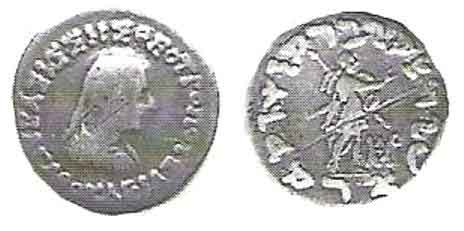
Drachm of Agathokleia at the beginning of her regency.
Obv: Diademed bust of Agathokleia, with drapery and necklace. Greek legend BASILISSES THEOTROPOU AGATHOKLEIAS "Godlike Queen Agathokleia".
Rev: King in military outfit, diademed, holding spear, bow, arrow and shield in his left hand, and extending his right hand in a benediction gesture. Kharoshthi legend "Maharajasa tratarasa dhramikasa Stratasa", "Great King, saviour and follower of the dharma, Strato".
Legacy
Buddhism
Main article: Greco-Buddhism
After the reign of Menander I, his son Strato I and several subsequent Indo-Greek rulers, such as Amyntas, Nicias, Peukolaos, Hermaeus, and Hippostratos, depicted themselves or their Greek deities forming with the right hand a symbolic gesture identical to the Buddhist vitarka mudra (thumb and index joined together, with other fingers extended), which in Buddhism signifies the transmission of the Buddha's teaching. At the same time, right after the death of Menander, several Indo-Greek rulers also started to adopt on their coins the Pali title of "Dharmikasa", meaning "follower of the Dharma" (the title of the great Indian Buddhist king Ashoka was Dharmaraja "King of the Dharma"). This usage was adopted by Strato I, Zoilos I, Heliokles II, Theophilos, Peukolaos and Archebios.
Altogether, the conversion of Menander to Buddhism suggested by the Milinda Panha seems to have triggered the use of Buddhist symbolism in one form or another on the coinage of close to half of the kings who succeeded him. Especially, all the kings after Menander who are recorded to have ruled in Gandhara (apart from the little known Demetrius III) display Buddhist symbolism in one form or another.
Both because of his conversion and because of his unequaled territorial expansion, Menander may have contributed to the expansion of Buddhism in Central Asia. Although the spread of Buddhism to Central Asia and Northern Asia is usually associated with the Kushans, a century or two later, there is a possibility that it may have been introduced in those areas from Gandhara "even earlier, during the time of Demetrius and Menander" (Puri, "Buddhism in Central Asia").
Representation of the Buddha
Main article: Greco-Buddhist art
The anthropomorphic representation of the Buddha is absent from Indo-Greek coinage, suggesting that the Indo-Greek kings may have respected the Indian an-iconic rule for Buddhist depictions, limiting themselves to Buddhist symbolism only. Consistently with this perspective, the actual depiction of the Buddha would be a later phenomenon, usually dated to the 1st century, emerging from the sponsorship of the syncretic Kushan Empire and executed by Greek, and, later, Indian and possibly Roman artists. Datation of Greco-Buddhist statues is generally uncertain, but they are at least firmly established from the 1st century.
Another possibility is that the Indo-Greeks may not have considered the Buddha strictly as a God, but rather as an essentially human sage or philosopher, in line with the traditional Nikaya Buddhist doctrine. Just as philosophers were routinely represented in statues (but certainly not on coins) in Antiquity, the Indo-Greek may have initiated anthropomorphic representations of the Buddha in statuary only, possibly as soon as the 2nd-1st century BC, as advocated by Foucher and suggested by Chinese murals depicting Emperor Wu of Han worshipping Buddha statues brought from Central Asia in 120 BC (See picture) ). An Indo-Chinese tradition also explains that Nagasena, also known as Menander's Buddhist teacher, created in 43 BC in the city of Pataliputra a statue of the Buddha, the Emerald Buddha, which was later brought to Thailand.
Stylistically, Indo-Greek coins generally display a very high level of Hellenistic artistic realism, which declined drastically around 50 BC with the invasions of the Indo-Scythians, Yuezhi and Indo-Parthians. The first known statues of the Buddha are also very realistic and Hellenistic in style and are more consistent with the pre-50 BC artistic level seen on coins.
This would tend to suggest that the first statues were created between 130 BC (death of Menander) and 50 BC, precisely at the time when Buddhist symbolism appeared on Indo-Greek coinage. From that time, Menander and his successors may have been the key propagators of Buddhist ideas and representations: "the spread of Gandhari Buddhism may have been stimulated by Menander's royal patronage, as may have the development and spread of Gandharan sculpture, which seems to have accompanied it" (Mc Evilly, "The shape of ancient thought", p378)
Geography
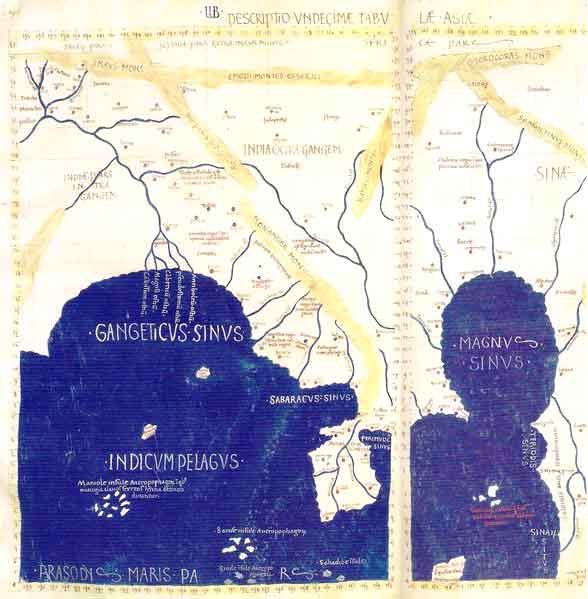
Detail of Asia in the Ptolemy world map. The "Menander Mons" are in the center of the map, at the east of the Indian subcontinent, right above the Malaysian Peninsula. [Source]
In Classical Antiquity, from at least the 1st century, the "Menander Mons", or "Mountains of Menander", came to designate the mountain chain at the extreme east of the Indian subcontinent, today's Naga Hills and Arakan, as indicated in the Ptolemy world map of the 1st century geographer Ptolemy.
| INDO-GREEK KINGS AND THEIR TERRITORIES Based on Bopearachchi (1991) |
||||||||||||
| Territories/ Dates |
PAROPAMISADAE |
ARACHOSIA | GANDHARA | WESTERN PUNJAB | ||||||||
|---|---|---|---|---|---|---|---|---|---|---|---|---|
| 200-190 BC | Demetrius I |
|||||||||||
| 190-180 BC | Agathocles |
Pantaleon |
||||||||||
| 185-170 BC | Antimachus I |
|||||||||||
| 180-160 BC | Apollodotus I |
|||||||||||
| 175-170 BC | Demetrius II |
|||||||||||
| 160-155 BC | Antimachus II |
|||||||||||
| 170-145 BC | Eucratides |
|||||||||||
| 155-130 BC | ||||||||||||
| 130-120 BC | Zoilos I |
Agathokleia |
||||||||||
| 120-110 BC | Lysias |
Strato I |
||||||||||
| 110-100 BC | Antialcidas |
Heliokles II |
||||||||||
| 100 BC | Polyxenios |
Demetrius III |
||||||||||
| 100-95 BC | Philoxenus |
|||||||||||
| 95-90 BC | Diomedes |
Amyntas |
Epander |
|||||||||
| 90 BC | Theophilos |
Peukolaos |
Thraso | |||||||||
| 90-85 BC | Nicias |
Menander II |
Artemidoros |
|||||||||
| 90-70 BC | Hermaeus |
Archebios |
||||||||||
| Yuezhi tribes | Maues (Indo-Scythian) | |||||||||||
| 75-70 BC | Telephos |
Apollodotus II |
||||||||||
| 65-55 BC | Hippostratos |
Dionysios |
||||||||||
| 55-35 BC | Azes I (Indo-Scythian) | Zoilos II |
||||||||||
| 55-35 BC | Apollophanes  |
|||||||||||
| 25 BC- 10 AD | Strato II |
|||||||||||
| Rajuvula (Indo-Scythian | ||||||||||||
Notes
- ^ Strabo 11.11.1 Full text
- ^ "Indo-Greek, Indo-Scythian and Indo-Parthian coins in the Smithsonian institution", Smithsonian Institution, Bopearachchi, p19, quoting the analysis of N.G. Majumdar, D.C. Sicar, S.Konow
- ^ Chapter XXIX of the Mahavamsa: Text
- ^ Regarding the coinage of Menander II: "All numismatist, with the exception of Lahiri and A.D.H. Bivar, have attributed these emissions to Menander Soter (Menander I "the Saviour"), and dated them to the end of his reign. A.Cunningham and W.W.Tarn claim that the royal profile is that of an older man, and attribute this coinage in Eastern Punjab worshops." (Bopearachchi, "Monnaies Gréco-Bactriennes et Indo-Grecques", p108, translated from the French original)
- ^ A single mint mark is known which is common to Menander I and Agathokleia/Strato I: the "P" with "A" on its side. It only appears in very few instances on the coins of Agathokleia and Strato I.
- ^ All the coins of Agathokleia as Queen-Mother, where, middle-aged, she is alone on her coins with the bow and arrow quiver on the reverse, have mint marks (two of them, Bopearachchi mint marks 227 (thought to represent Charsada) and 244 (thought to represent Taxila)) similar to those of Menander II: See Agathokleia coins
- ^ Altogether ten coins types (Bopearachchi 22A/B 26A 28A 28B (for two mint marks -Bopearachchi mint marks 227 and 244-, the same as those shared by Agathokleia) are shared by Strato I with Menander II, especially two coin types in which Strato I is very young, almost adolescent, and still uses Athena peacefully holding Nike on her forward arm (22A/B).
- ^ Bopearachchi mintmark 244, present on coins of Menander II, is considered by most numismats as characteristic of Taxila.
- ^ A hoard of 96 coins of Strato I was found in Mathura, together with coins of Menander (S.P. Noe, A bibliography of Greek coin-hoards, Numismatic Notes and Monographs, 1925, p126., quoted by W.W. Tarn, p. 228)
- ^ "Indo-Greek, Indo-Scythian and Indo-Parthian coins in the Smithsonian institution", Smithsonian Institution, Bopearachchi, p33
- ^ A passage in the "Mahā-parinibbâna sutta" of the "Dighanikaya" relates the dispute of Indian kings over the ashes of the Buddha, which they finally shared between themselves and enshrined in a series of stupas.
- ^ Plutarch "Political precepts", p147-148 Full text (30MB Pdf)
- ^ The mint-mark in common is Bopearachchi mint-mark 244.
See also
References
- "Monnaies Gréco-Bactriennes et Indo-Grecques, Catalogue Raisonné", Osmund Bopearachchi, 1991, Bibliothèque Nationale de France, ISBN 2-7177-1825-7.
- "The Shape of Ancient Thought. Comparative studies in Greek and Indian Philosophies" by Thomas McEvilley (Allworth Press and the School of Visual Arts, 2002) ISBN 1-58115-203-5
- "Buddhism in Central Asia" by B.N. Puri (Motilal Banarsidass Pub, January 1, 2000) ISBN 81-208-0372-8
- The Greeks in Bactria and India (Cambridge Library Collection - Classics) , W.W. Tarn,
- "Dictionary of Buddhism" Damien Keown, Oxford University Press ISBN 0-19-860560-9
- "De l'Indus à l'Oxus, Archéologie de l'Asie Centrale", Osmund Bopearachchi, Christine Sachs, ISBN 2-9516679-2-2
- "The Diffusion of Classical Art in Antiquity" by John Boardman (Princeton University Press, 1994) ISBN 0-691-03680-2
- "The Crossroads of Asia. Transformation in Image and symbol", 1992, ISBN 0-9518399-1-8
- "Indo-Greek, Indo-Scythian and Indo-Parthian coins in the Smithsonian institution", Smithsonian Institution, Bopearachchi, 1993
Links
- Coins of King Menander
- More coins of Menander
- Kapisa coinage of Menander
- The Debate of King Milinda (pdf)
Greeks:
A - B - C - D - E - F - G - H - I - J - K - L - M -
N - O - P - Q - R - S - T - U - V - W - X - Y - Z
| Ancient Greece
Science, Technology , Medicine , Warfare, , Biographies , Life , Cities/Places/Maps , Arts , Literature , Philosophy ,Olympics, Mythology , History , Images Medieval Greece / Byzantine Empire Science, Technology, Arts, , Warfare , Literature, Biographies, Icons, History Modern Greece Cities, Islands, Regions, Fauna/Flora ,Biographies , History , Warfare, Science/Technology, Literature, Music , Arts , Film/Actors , Sport , Fashion --- |
Retrieved from "http://en.wikipedia.org"
All text is available under the terms of the GNU Free Documentation License

